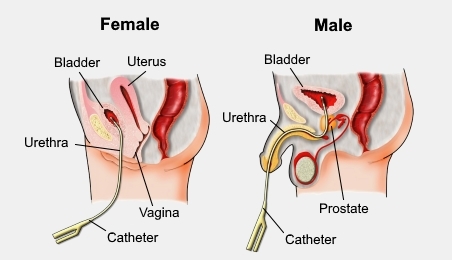Whakaurunga pūaha mimi Urinary catheters
When you might need a catheter
You may need a catheter for a short period, such as before or after surgery, or you may need it long term or permanently.
A urinary catheter can be fitted through your urethra (the tube that carries wee from your bladder). This is called a urethral catheter. A catheter can also be fitted through the wall of your stomach. This is called a suprapubic catheter. In both cases, a small, inflated balloon keeps the catheter in place.

Wee flows through the catheter and collects in a drainage bag that is connected to the end of the tube.
A nurse may change your drainage bag, or you may be taught to do it yourself. Your medical team will discuss this with you, as well as how often your bags are changed.
Using a catheter during the day
You can secure the day bag to your thigh or calf using straps. You can attach the bag to whichever side feels most comfortable. You should always keep the bag lower than your bladder.
The drainage bag has a valve at the bottom that you open to drain the wee that is been collected. You'll be taught how to do this.
You should empty the drainage bag every three to four hours during the day, or before the bag overfills.
Using a catheter at night
At night, you will connect the day bag (or valve) to a larger bag called a night bag. You'll open the valve at the bottom of the day bag to allow the wee to drain freely into the night bag. This is so you do not have to wake up to empty your bag overnight and so you can move around when in bed.
You should place the night bag lower than your bed. Placing it in a container such as an ice cream container is a good idea in case there is any leakage.
In the morning, you will close the valve at the bottom of the day bag and disconnect the night bag. You can empty the collected wee down the toilet.
Clean the night bag after each use with warm soapy water and allow it to dry thoroughly. Store the dried bag in a clean sealed plastic bag ready for the next time you use it.
Catheter valves
Some people with catheters use a catheter valve, with or without a drainage bag. When the valve is closed, it stops the wee draining from your bladder. You should open the valve every 3 to 4 hours or when your bladder feels full so the wee can drain into the toilet or a container.
Hygiene
Always wash your hands with warm water and soap after touching your catheter equipment.
Maintain good personal hygiene by washing yourself daily with soap and water.
Wash the area around where the catheter enters your body with soap and water daily. Dry it well with a soft towel.
Do not use talcum powder or creams around the catheter unless your healthcare provider has prescribed them.
Keeping your catheter working properly
Avoid getting constipated as this can affect your wee flow.
Avoid having kinks in your catheter tubing.
Make sure you have a spare catheter and related equipment ready for the next change.
Supplies
If you need a catheter for a long period, your healthcare provider will arrange for the District Nursing Service to manage your catheter needs. The District Nursing Service will contact you once they receive the referral.
Clinical review
This content was written by HealthInfo clinical advisers. It has been adapted for Health Information and Services.